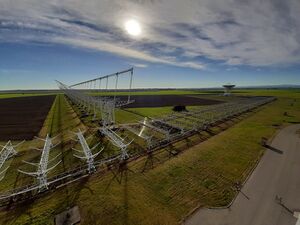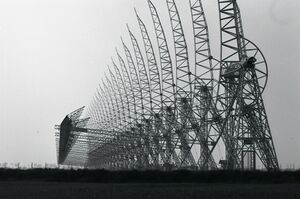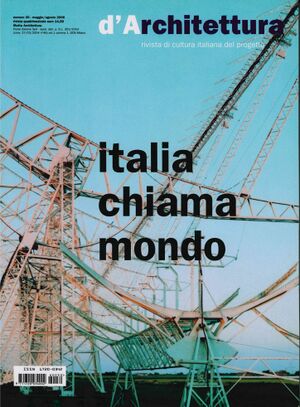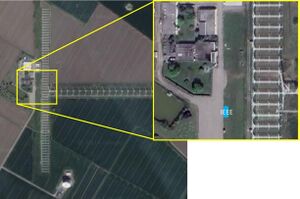Milestone-Proposal:Northern Cross Radio Telescope
To see comments, or add a comment to this discussion, click here.
Docket #:2024-18
This proposal has been submitted for review.
To the proposer’s knowledge, is this achievement subject to litigation? No
Is the achievement you are proposing more than 25 years old? Yes
Is the achievement you are proposing within IEEE’s designated fields as defined by IEEE Bylaw I-104.11, namely: Engineering, Computer Sciences and Information Technology, Physical Sciences, Biological and Medical Sciences, Mathematics, Technical Communications, Education, Management, and Law and Policy. Yes
Did the achievement provide a meaningful benefit for humanity? Yes
Was it of at least regional importance? Yes
Has an IEEE Organizational Unit agreed to pay for the milestone plaque(s)? Yes
Has the IEEE Section(s) in which the plaque(s) will be located agreed to arrange the dedication ceremony? Yes
Has the IEEE Section in which the milestone is located agreed to take responsibility for the plaque after it is dedicated? Yes
Has the owner of the site agreed to have it designated as an IEEE Milestone? Yes
Year or range of years in which the achievement occurred:
1964
Title of the proposed milestone:
Northern Cross Radio Telescope, 1964
Plaque citation summarizing the achievement and its significance; if personal name(s) are included, such name(s) must follow the achievement itself in the citation wording: Text absolutely limited by plaque dimensions to 70 words; 60 is preferable for aesthetic reasons.
The pioneering radio telescope Croce del Nord was inaugurated in October 1964. It consists of cylindrical parabolic reflectors with a collecting area of 30.000 m^2. The radio telescope included many innovative technological features in mechanical and electronic engineering areas to create a huge instrument capable of investigating the origin of the Universe. It became well known throughout the world thanks to the Bologna Catalogs, which contain 23.000 sources at 408 MHz.
200-250 word abstract describing the significance of the technical achievement being proposed, the person(s) involved, historical context, humanitarian and social impact, as well as any possible controversies the advocate might need to review.
The Northern Cross Radio Telescope (Croce del Nord), operated by the Istituto di Radio Astronomia of the Istituto Nazionale di Astrofisica, is an imposing instrument of about 600 x 600 m in size, located near Medicina (Bologna, Italy) and conceived in the ‘60s to detect radio waves of cosmic origin at 408 MHz. It is the pioneering instrument that gave rise to radio astronomy in Italy and this year, 2024, it will celebrate the 60th anniversary of its inauguration.
The realization of such a big radio telescope with a collecting area of about 30.000 m2 has involved innovative technologies achievements in various fields of mechanical and electronic engineering, such as antennas, radio frequency active and passive circuits, interferometry and signal processing.
The Northern Cross has become well known all over the world owing to the realization of the Bologna Catalogs of radio astronomical sources, notably B2 and B3, containing about 23.000 objects in total.
Owing to its relevance in radio astronomy and its majestic structure, the Northern Cross is an iconic instrument, that has been also used through the years in movies and, as cover image, in books and magazines.
Nowadays, the instrument is active in monitoring Fast Radio Bursts and in tracking low-Earth orbit space debris, and it is undergoing an upgrade aimed at keeping this facility at the forefront of research infrastructures.
IEEE technical societies and technical councils within whose fields of interest the Milestone proposal resides.
Antennas & Propagation Society
In what IEEE section(s) does it reside?
IEEE Italy Section
IEEE Organizational Unit(s) which have agreed to sponsor the Milestone:
IEEE Organizational Unit(s) paying for milestone plaque(s):
Unit: IEEE Italy Section
Senior Officer Name: Gianfranco Chicco
IEEE Organizational Unit(s) arranging the dedication ceremony:
Unit: IEEE Italy Section
Senior Officer Name: Gianfranco Chicco
IEEE section(s) monitoring the plaque(s):
IEEE Section: IEEE Italy Section
IEEE Section Chair name: Gianfranco Chicco
Milestone proposer(s):
Proposer name: Pietro Bolli
Proposer email: Proposer's email masked to public
Please note: your email address and contact information will be masked on the website for privacy reasons. Only IEEE History Center Staff will be able to view the email address.
Street address(es) and GPS coordinates in decimal form of the intended milestone plaque site(s):
Medicina radio astronomical station, Via Fiorentina 3513 – 40059 – Villafontana, Bologna (Italy)
Latitude: 44.523917 N Longitude: 11.645139 E
Describe briefly the intended site(s) of the milestone plaque(s). The intended site(s) must have a direct connection with the achievement (e.g. where developed, invented, tested, demonstrated, installed, or operated, etc.). A museum where a device or example of the technology is displayed, or the university where the inventor studied, are not, in themselves, sufficient connection for a milestone plaque.
Please give the details of the mounting, i.e. on the outside of the building, in the ground floor entrance hall, on a plinth on the grounds, etc. If visitors to the plaque site will need to go through security, or make an appointment, please give the contact information visitors will need. The site selected to host the milestone plaque is few meters in front of the Northern Cross Radio Telescope. The area is managed by the Istituto di Radioastronomia of the Istituto Nazionale di Astrofisica and is located in a rural area in the Po Valley.
The site consists of several buildings hosting offices, laboratories, control rooms, warehouses as well as two main radio astronomical facilities: the Northern Cross Radio Telescope and a parabolic dish with 32 meter of diameter.
Are the original buildings extant?
Yes, the original antenna and buildings are still extant.
The Northern Cross Radio Telescope is not only still present in all its size but is still operational. A refurbishment has been conducted in the last years on the North-South arm, while another one is currently in progress on the East-West arm. After the completion of this upgrade, it is expected that the antenna will continue its activity for decades.
Details of the plaque mounting:
The plaque, only in English, will be installed over an exhibition plinth on the grounds that will be located nearby the street to access to the Medicina radio astronomical station. Visitors can admire the plaque with the Northern Cross radio telescope located in the background. The exhibition pedestal will be designed ad hoc by involving local young artists.
The current idea is to have a cyclopean stone with a natural effect coming from a ‘pietra serena’ quarry, of variable dimensions, but approximately 120 x 70 cm with a base and a height of approximately 120/130 cm, suitable for hosting the license plate in the top front part. To perimeter the area, three other larger but lower cyclopean boulders will be placed to be used as a seat to admire the Northern Cross.
How is the site protected/secured, and in what ways is it accessible to the public?
The Medicina radio astronomical station is a restricted area, visited by scientists and engineers collaborating with the Institute. However, one of the missions of the Istituto Nazionale di Astrofisica is to promote the dissemination of scientific culture through astronomy teaching and outreach projects addressed to schools and society. In this framework, the Medicina Observatory is regularly made accessible to the general public and to the school groups, without any payment of fee. Guided tours of the local scientific facilities are organized on a weekly basis, in addition to periodically organized open days.
It is worth noticing that in the proximity of the radio telescopes, the Istituto di Radio Astronomia manages the visitor center "Marcello Ceccarelli", which contains an exhibition room with explanatory panels, historical instrumentation and a series of multimedia and interactive stations.
Who is the present owner of the site(s)?
Istituto di Radio Astronomia of the Istituto Nazionale di Astrofisica
What is the historical significance of the work (its technological, scientific, or social importance)? If personal names are included in citation, include detailed support at the end of this section preceded by "Justification for Inclusion of Name(s)". (see section 6 of Milestone Guidelines)
The realization of the Northern Cross Radio Telescope was triggered by the scientific debate alive in the early 60ies about the origin of the Universe. Two cosmological theories, the “Stationary State” (continuous creation of matter) and the “Big Bang” (expansion from a highly compressed state) divided the scientific community. The Northern Cross Radio Telescope was conceived by scientists at the Università di Bologna as a major research infrastructure able to observe, with a sensitivity better by more than an order of magnitude with respect to existing competitive radio telescopes, large numbers of weak and distant radio sources, thus allowing to distinguish between the two models.
The Northern Cross Radio Telescope was built to receive cosmic radio waves at the frequency of 408 MHz with a bandwidth of 2.5 MHz (widened in the following years to 16 MHz for pulsars research). It is a transit instrument, mechanically steerable only in declination, so it can solely observe those objects that are culminating on the local celestial meridian.
The radio telescope consists of two perpendicular arms, aligned to the East-West (EW) and North-South (NS) directions respectively, with reflecting surfaces composed by thin long steel wires 2 cm apart.
The EW arm consists of a single off-set parabolic-cylindrical antenna 564 m long and 35 m wide. Along the focal axis, at about 20 m from the reflecting surface, 1536 half-wavelength dipoles transform the incoming radio waves in measurable electric tension. The dipoles are subdivided into 6 sections having 256 dipoles each. Inside every section a sequential sum of the gathered signals is performed, following the so-called "Christmas tree" method, which allows to pass from 256 elementary signals to a single signal. The NS arm is composed by 64 symmetrical parabolic-cylindrical antennas (23.5 m x 7.5 m each), with an inter-distance between individual antennas of 10 m. In this case, the focal line of each antenna consists of 64 dipoles. In both arms, a proper illumination of the reflecting surface is assured by the presence in the focal line of a back-reflector.
The realization of the Northern Cross had impact in several fields:
Technological impact: At the time of construction, the Northern Cross Radio Telescope was one of the largest steerable reflector antennas ever built. Even today, it is among the largest radio telescopes in the world, and it is unique among instruments of its kind. Its realization was possible thanks to the development of pioneering technologies in various fields of engineering disciplines. Over the years, the technology of the Northern Cross has been kept at the most advanced level to allow new research projects and to test innovative technologies for new radio telescopes, such as SKA (Square Kilometer Array), or beamforming systems later used in mobile telephony. After almost 60 years of activity and thanks to continuous research to maintain its cutting-edge performance, it is still used both for monitoring space debris within the European Union Space Surveillance and Tracking Program and in the field of transient astronomical sources.
Scientific impact: The instrument was able to survey about 23 000 objects producing two catalogs of radio sources (Bologna Catalogs, B2 and B3) that obtained several international recognitions. The two catalogs have been a legacy for the scientific community. Other research projects where the Northern Cross has contributed include studies of the variability of radio galaxies and quasars and the detection and monitoring of radio pulsars. Nowadays, the Northern Cross Radio Telescope is scientifically active in particular in the field of Fast Radio Bursts monitoring.
Professional impact: The construction and scientific usage of the Northern Cross Radio Telescope lead to the growth of a radio astronomy community in Italy, with both engineering and scientific competences. Over the following decades, Italian radio astronomers distinguished themselves for their high scientific abilities and played a leading role in the growth of radio astronomy worldwide.
Educational impact: The Northern Cross Radio Telescope contributed to the dissemination of radio astronomical knowledge to students ranging from primary schools to university as well as to the general public.
What obstacles (technical, political, geographic) needed to be overcome?
The project for the construction of one of the largest radio telescopes ever built in the world posed numerous engineering challenges:
- the entire program was designed and developed in-house and conducted by using theoretical and experimental knowledge, as no computer-aided software was available at the time;
- the realization of an enormous and movable surface required advanced knowledge in the design of the supporting structures;
- the requirement on the large sensitivity was accomplished not only by using a large collecting area but also through a minimization of the receiver noise temperature obtained by the beam forming network and by the amplifiers.
The main political challenges encountered were:
- to secure funding from the Ministero della Pubblica Istruzione. The total fund allocation was of 800 million Italian Lire, that correspond to about 11 MEuro at 2024;
- to re-size the project (a T-shape instead of a full cross), because of limited funding, still ensuring to reach the stated scientific goals;
- to interact with the Consiglio Nazionale delle Ricerche (CNR) for the establishment of a Radio Astronomy Laboratory/Institute, for the scientific use and maintenance of the radio telescope; (at that time the Istituto Nazionale di Astrofisica did not exist)
- to attract talented researchers and engineers to strengthen the radio astronomical group.
Finally, as far as the main geographic challenges of the facility are concerned, we mention:
- to convince the local population that the radio telescope, as no-transmitting instrument, was not creating any danger to the people;
- to create the necessary infrastructures in a rural area to host a scientific instrument;
- to maintain the site quiet from radio frequency interference, by continuously monitoring man-made signals (for instance telecommunication, radars) to assure that the radio frequency band 408 MHz, allocated with a primary status to the radio astronomy service, was not interfered.
What features set this work apart from similar achievements?
“It is a nice collection of original ingenuities” has been the comment of one distinguished researcher visiting the Northern Cross Radio Telescope. This quote correctly describes the originality, simplicity and cleverness of several technical choices applied throughout the Northern Cross Radio Telescope. Here after some of the most remarkable technological achievements:
- A novel antenna design composed by two parabolic-cylindrical reflector arms with a unique offset configuration in the East-West direction and 64 individual antennas for the North-South arm;
- a transit instrument steerable in elevation and able to observe the sky as it passes through the local celestial meridian; by changing day by day the pointing elevation of the antenna, it was possible to explore wide areas of the sky;
- a single polarization antenna was identified as a good compromise to simplify the antenna structure while maintaining an optimal antenna gain due to the non-polarized nature of celestial radio sources;
- a reflector surface composed of extremely long and continuous wires (up to 564 m for the EW arm) made by austenitic stainless steel. Thermal expansion effects, which can produce a maximum length variation of 500 mm between winter and summer seasons, are compensated by means of a counterweight and a pulley system that also serves to maintain the tension of the mirror (7 kg per wire);
- one of the first radio telescopes working as interferometer correlating the 6 section receivers along the East-West arm and the 8 section receivers in the North-South direction with an overall resolution of the antenna beam equal to 4 x 4 arcmin;
- an elevation-dependent phase compensation system based on a variable liquid (kerosene) dielectric transmission line allowing the phases received by the North-South reflectors to be varied continuously along with the pointing of the antenna;
- a beam forming network based on metallic cavities to combine, with low losses, the signals received by the individual dipoles. This beam forming network is also responsible for the transformation of the characteristic impedance and for the balun;
- a high flexibility instrument thanks to the different observing strategies: the two arms could operate individually in tracking-mode and/or in combination for imaging of extended sky regions.
The Northern Cross Radio Telescope has been kept in good condition through diligent maintenance and upgrades, so that it is still used today for technological and scientific programs. The continued operational life of the Northern Cross Radio Telescope shows how forward-thinking the project was conceived.
Why was the achievement successful and impactful?
Supporting texts and citations to establish the dates, location, and importance of the achievement: Minimum of five (5), but as many as needed to support the milestone, such as patents, contemporary newspaper articles, journal articles, or chapters in scholarly books. 'Scholarly' is defined as peer-reviewed, with references, and published. You must supply the texts or excerpts themselves, not just the references. At least one of the references must be from a scholarly book or journal article. All supporting materials must be in English, or accompanied by an English translation.
The following references are the original papers describing the design of the antenna, of the receiver and its operation:
- Braccesi, M. Ceccarelli, “The Italian Cross Radio Telescope – I. Design of the antenna,” Il Nuovo Cimento, vol. 23, n. 1, pages 208-215, 1962. https://www.ira.inaf.it/slide-story/61-art-ric/61-Italian-cross.pdf
- G. Gelato, C. Rosatelli, G. Sinigaglia, “The Italian Cross Radio Telescope – II. Preliminary Design of the Receiver,” Il Nuovo Cimento, vol. 23, n. 1, pages 254-257, 1962. https://www.ira.inaf.it/slide-story/61-art-ric/61-Nuovo-cimento-02.pdf
- Braccesi, M. Ceccarelli, G. Colla, R. Fanti, A. Ficarra, G. Gelato, G. Grueff, G. Sinigaglia, “The Italian Cross Radio Telescope – III. Operation of the Telescope,” Il Nuovo Cimento, vol. 62B, pages 13-19, 1969. https://drive.google.com/file/d/1SZ-i21NHC6ZISj5v4mCHK47Ds4N2QuHf/view?usp=sharing
The next article reports a recent brief history of the Northern Cross Radio Telescope.
- G. Bianchi, F. Perini, G. Setti, “A brief history of the Northern Cross Radio Telescope,” accepted for an oral presentation at the 2023 HISTELCON conference, Florence (Italy), 7-9 September 2023.
The elevation-dependent phase compensation system based on a variable liquid is described in the following article:
- Braccesi, M. Ceccarelli, G. Gelato, G. Sinigaglia, “A Simple and Accurate Liquid Dielectric Variable Length Line,” Proceedings of the IEEE, vol. 54, pages 69-70, 1966. https://ieeexplore.ieee.org/stamp/stamp.jsp?arnumber=1446520
Other technological-oriented papers on the Northern Cross Radio Telescope and its application are:
- G. Virone, R. Sarkis, C. Craeye, G. Addamo, O.A. Peverini, “Gridded Vivaldi Antenna Feed System for the Northern Cross Radio Telescope,” IEEE Transactions on Antennas and Propagation, vol. 59, 6, 2011.
- S. Montebugnoli, G. Bianchi, C. Bortolotti, A. Cattani, F. Ghelfi, A. Maccaferri, F. Perini, J. Roda, M. Roma, G. Zacchiroli, L. Zoni, “Re-instrumentation of the Northern Cross radio telescope for a SKA cylindrical concentrator based test bed,” 34th European Microwave Conference, vol. 3, pages 1537-1540, 11-15 Oct. 2004.
- G. Bianchi, G. Naldi, F. Fiocchi, et al., “A new concept of bi-static radar for space debris detection and monitoring”, Proceeding of the 1st International Conference on Electrical, Computer, Communications and Mechatronics Engineering, 2021, pp. 1-6.
On the scientific side, the B2 and B3 catalogs had a strong scientific impact for many years all over the world. In particular, the article published on Astronomy and Astrophysics journal in 1970 with the first part of the catalogue (3 000 radio sources) was for a few years the most internationally cited article among all Italian astronomy articles.
- G. Colla, C. Fanti, R. Fanti, A. Ficarra, L. Formiggini, E. Gandolfi, G. Grueff, C. Lari, L. Padrielli, G. Roffi, P. Tomasi, M. Vigotti, “A catalogue of 3235 radio sources at 408 MHz”, Astron. Astrophys. Suppl. Ser. 1, page 281, 1970.
- G. Colla, C. Fanti, R. Fanti, A. Ficarra, L. Formiggini, E. Gandolfi, C. Lari, B. Marano, L. Padrielli, P.Tomasi, “The B2 Catalogue of radio sources - second part”, Astron. Astrophys. Suppl. 7, page 1, 1972.
- G. Colla, C. Fanti, R. Fanti, A. Ficarra, L. Formiggini, E. Gandolfi, I. Gioia, C. Lari, B. Marano, L. Padrielli, P. Tomasi, “The B2 catalogue of radio sources - third part”, Astron. Astrphys. Suppl. 11, page 291, 1973.
- C. Fanti, R. Fanti, A. Ficarra, L. Padrielli, “The B2 catalogue of radio sources - fourth part”, Astron. Astrophys. Suppl. 18, page 147, 1974.
A new area of scientific use of the Northern Cross is the monitoring of Fast Radio Bursts. Here after the papers published on these transient radio pulses of high-energy astrophysical origin:
- N.T. Locatelli, G. Bernardi, G. Bianchi, et al., “The Northern Cross fast radio burst project – I. Overview and pilot observations at 408 MHz”, MNRAS, vol. 494, pages 1229, 2020.
- M. Trudu, M. Pilia, G. Bernardi, A. Addis, G. Bianchi, et al., “The Northern Cross Fast Radio Burst project - II. Monitoring of repeating FRB 20180916B, 20181030A, 20200120E, and 20201124A”, MNRAS, vol. 513, 2, pages 1858–1866, 2022.
- D. Pelliciari, G. Bernardi, M. Pilia, G. Naldi, et al., “The Northern Cross Fast Radio Burst project - III. The FRB-magnetar connection in a sample of nearby galaxies”, A&A, Volume 674, June 2023.
As a supplemental material, links to multimedia material are reported below (all of them in Italian language):
- During the construction, in 1963, the Italian famous movie director Michelangelo Antonioni shot some scenes of one of his best known films, “Deserto Rosso”, on the site of the Northern Cross (from 35:00 to 37:30, mm:ss), https://www.dailymotion.com/video/x87mbtk
- The Northern Cross, half a century of Italian radio astronomy, https://www.youtube.com/watch?v=R3TWq_smwm0
- Space debris, a cross will protect us, https://www.youtube.com/watch?v=pblB0-r64-M
Supporting materials (supported formats: GIF, JPEG, PNG, PDF, DOC): All supporting materials must be in English, or if not in English, accompanied by an English translation. You must supply the texts or excerpts themselves, not just the references. For documents that are copyright-encumbered, or which you do not have rights to post, email the documents themselves to ieee-history@ieee.org. Please see the Milestone Program Guidelines for more information.
Please email a jpeg or PDF a letter in English, or with English translation, from the site owner(s) giving permission to place IEEE milestone plaque on the property, and a letter (or forwarded email) from the appropriate Section Chair supporting the Milestone application to ieee-history@ieee.org with the subject line "Attention: Milestone Administrator." Note that there are multiple texts of the letter depending on whether an IEEE organizational unit other than the section will be paying for the plaque(s).
Please recommend reviewers by emailing their names and email addresses to ieee-history@ieee.org. Please include the docket number and brief title of your proposal in the subject line of all emails.




